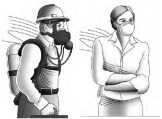The day will be marked in Washington, D.C., and on six continents with candlelight vigils, conferences, and rallies calling to governments to pay more attention to occupational deaths and injuries.
Inspectors identified other hazards including locked exits, obstructed exit access, and an unmarked exit; lack of welding screens and personal protective equipment for welders; untrained forklift operators; excess carbon monoxide levels from forklifts; and numerous electrical safety deficiencies including exposed live electrical parts.

Taking place on 2009's Workers Memorial Day, the hearing by the U.S. Senate Subcommittee on Employment and Workplace Safety has a strong lineup of witnesses -- including Tammy Miser, shown here -- who will describe the true cost of workplace fatalities.
Under the terms of the proposed settlement, which is currently available for public comment, Puainako Town Center in Hilo, Hawaii, must close all eight large capacity cesspools owned and operated by the company by May 1, 2009.

Texas Mutual Insurance Company launched it in Lubbock on a trial basis with several participating employers. "Workplace Accidents Are a Pain. Work Smart" is the theme, and a free movie ticket can be earned by taking a safety quiz.
A 2005 report by the Restaurant Opportunities Center of New York and the New York City Restaurant Industry Coalition found that "nearly half of the 530 workers surveyed reported that it gets unsafely hot in the kitchen where they work."
Sooner than expected, with about half of the listed prosecution witnesses not called to testify, the prosecutors in the federal court jury trial in Missoula, Mont., will rest its case early this week, according to reporters covering it. The company and five former managers are charged with conspiring to conceal evidence of the dangers of asbestos contamination in the Libby community from the dust produced by a vermiculite mine.

Air quality standards have become more stringent, and, according to EPA, air pollution levels have declined. Still, ground-level ozone and particle matter can pose serious health problems, which is why the index is important.
The Georgia Local Section of the American Industrial Hygiene Association, the American Society of Safety Engineers' Georgia Chapter, and the Georgia Tech Research Institute's Occupational Safety and Health Division are taking part.
The "Grand Opportunities" program, highlighted this week by the National Institutes of Health, will invest about $200 million in large-scale research projects to boost public health, health care delivery, and biomedical R&D.
Three items alleging the employer failed to provide guardrails on painters' scaffolds are now back for an administrative law judge's consideration. They've been litigated for years.
The company disclosed more than 680 violations of water, air, hazardous waste, emergency planning and preparedness, and pesticide regulations to EPA after auditing 12 facilities it acquired from DuPont in 2004.

The agency yesterday asked coal mine companies to offer help in the research, which will examine methane accumulation in sealed areas like the one that exploded in the Sago Mine, depicted here, in January 2006.
The company has been fined $121,500 for violations associated with process safety management, hazardous waste operations, and emergency response, including the company's failure to identify all of the causal factors of the incident during the investigation. The chemical release resulted in the evacuation of residents living within a three-mile radius of the facility.
Employers cannot rely on online or video training tools as the sole source of training because physical manipulation of actual components of PPE (as opposed to virtual components of PPE) must be part of the program, the agency notes.

Chronic Obstructive Pulmonary Disease was the underlying cause of death for 718,077 people 25 and older in 2000-2005, with annual deaths rising from 116,494 in 2000 to 126,005 in 2005, according to the study published in JAMA.
The company, a small municipal solid waste burner, was accused of not taking the correct measures to control its mercury, dioxin, and furan emissions.

Among other things, the agency's new, 51-page guidance document explains how to use Assigned Protection Factors numbers and Maximum Use Concentration limits, per the 2006 revisions to its Respiratory Protection standard.
In a field where hand washing and hygiene is of utmost importance, studies indicate compliance among health care providers is well below 50 percent, on average.